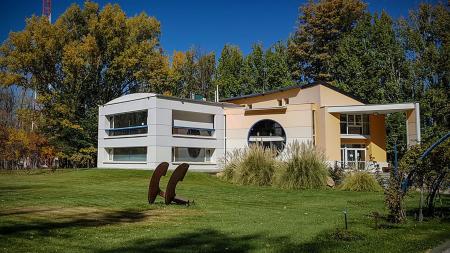The cosmic ray observatory Pierre Augerthe largest in the world, which since 2004 captures in Malargüe, Mendoza, the rain of particles in their collision with the atmosphere, made important advances in improving its detection systems, by incorporating “more modern and precise electronics”, after a new investment of 15 million dollars.
The group of scientists faced there technological improvements with the installation of modern equipment detectors that demanded a investment of 15 million dollars financed by the 18 countries participating in the initiative “which are already giving the first very positive results,” the project manager, Ingomar Allekotte, told Télam.
The Observatory consists of an array of 1,600 surface detectors, spaced 1.5 kilometers apart and covering a total area of 3,000 square kilometers, which are complemented by a set of 24 highly sensitive fluorescence telescopes, which, on clear nights and without a moon, they watch the atmosphere for the faint ultraviolet light produced by cascades of cosmic rays as they pass through the air.
For her part, the Mendoza astronomer beatriz garciaauthority on Pierre Auger, explained: “We observe very small subatomic particles but they come with very high. Energies that cannot be achieved in terrestrial accelerators or man-made accelerators. Understanding those cosmic rays helps us understand how the universe works at its most fundamental scale.”
When a very high-energy cosmic ray strikes Earth’s atmosphere, a cascade of secondary particles is produced, and that’s what the Auger detectors reveallocated in Malargüe, south of Mendoza, a city chosen at the end of the nineties to capture these astrophysical phenomena that occur in space outside our galaxy, the Milky Way.
In this way the energy, direction of arrival and the nature of the most energetic cosmic rays are determined.
The Auger employs 50 employees in Malargüe, 35 of whom are permanent, but about 500 scientists from almost a hundred institutions from 18 countries participate.
In its beginnings, the observatory had two types of detectors: “surface ones” (about 1,600 water tanks that can be easily seen along National Route 40); and the “fluorescence” ones (telescopes located in four buildings on the periphery of the surface detectors).
Allekotte explained that now “improvements to the detection systems are being implemented, consisting of a replacement of the electronics of all the surface detectors, with more modern, fast and precise electronics”.
In addition, the investment contemplates the addition of scintillation detectors placed on top of each of the surface detectors, and others capable of capturing very faint radio signals that are produced in the particle cascades (radio antennas that detect at the frequency 30 -80 MHz, which are also installed on top of the surface detectors).
When a very high-energy cosmic ray strikes Earth’s atmosphere, a cascade of secondary particles is produced, and that’s what the Auger detectors reveal
The new detectors emit a dim light when they are traversed by cosmic radiation, such as that produced in atmospheric showers caused by high-energy cosmic rays.
This “scintillation light” is then collected inside the detector by optical fibers, which direct it towards very sensitive photodetectors, with which these events are recorded, Allekotte said.
Each Scintillation Detector (SSD for “Surface Scintillation Detector”) measures about four square meters and will be mounted on each of the Observatory’s 1,660 surface detectors.
The objective is to extend the measurement of cosmic showers using an alternative detection system, with different sensitivity to different types of particles. (electrons, positrons, photons, muons).
This will make it possible to determine the relative amount of the different particles in each cosmic shower. With these data, it will be possible to infer the nature of the primary cosmic ray that gave rise to the rain, that is, whether it is a light atomic nucleus (a proton) or a heavier nucleus (such as a nucleus of a carbon atom). iron).
“We are installing them and now an evaluation by the financing agencies must verify that this works well, to continue for another ten years,” the researcher stated.
Finally, he announced that the new bet “is to install underground detectors that are like scintillators but are located underground, to measure the amount of muons (they are like electrons but 200 times heavier) in the particle cascades.
After these facilities, next year will be key to moving forward with this project, because the results will be evaluated to determine whether or not it will continue to be developed in Malargüe, “but it is already working according to what we expected,” said the researcher from the National Commission for Atomic Energy (CNEA) and professor at the Balseiro Institute.
In this scientific project there are collaborators from countries such as Brazil, Germany, Italy, France and the Czech Republic.
Meanwhile, the provincial government has just given an important nod to the observatory after confirming that it will carry out some works that have been pending for a long time, for example roads, for the continuity of scientific progress.
“We want to transmit certainties regarding the works that are needed and I hope that the evaluation is auspicious so that they stay in Malargüe for several more decades,” the infrastructure minister, Mario Isgro, recently promised.
The official stressed that “it is about improving the state of routes 188, 186 and 40, the latter with a national budget for next year.”
“We want to continue learning about how cosmic ray detection systems work. This scientific project gave Malargüe a lot of visibility internationally and generated synergy with the city and its inhabitants. We hope to continue operating the Observatory for another decade Allekotte concluded.

















